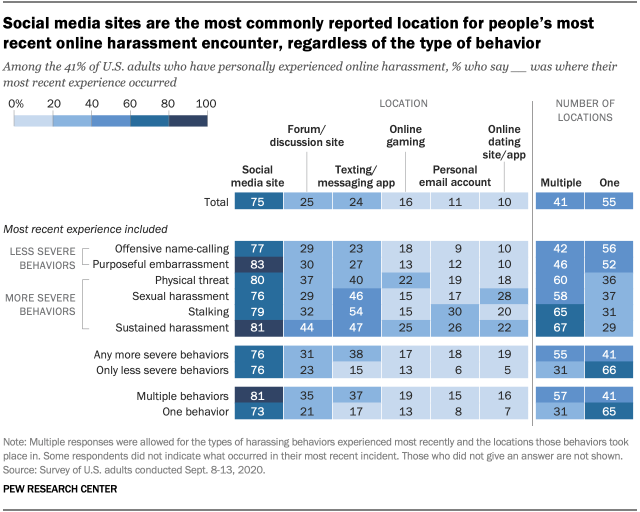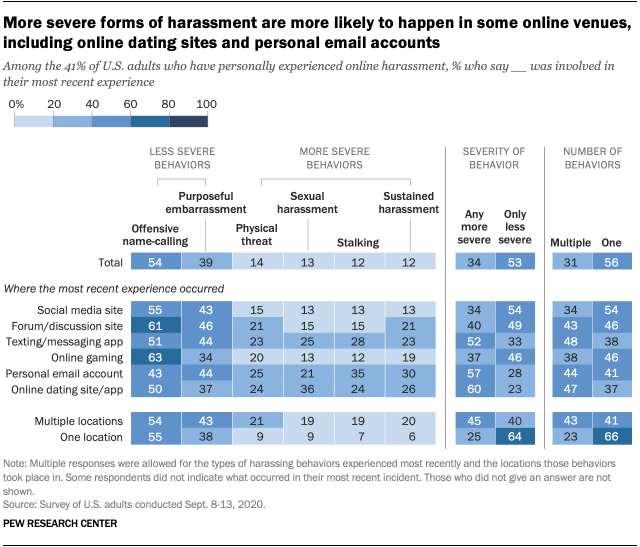
As has been the case since at least 2014, social media sites are the most common place Americans encounter harassment online, according to a September 2020 Pew Research Center survey. But harassment often occurs in other online locations, too.
Overall, three-quarters of U.S. adults who have recently faced some kind of online harassment say it happened on social media. But notable shares say their most recent such experience happened elsewhere, including on forum or discussion sites (25%), texting or messaging apps (24%), online gaming platforms (16%), their personal email account (11%) or online dating sites or apps (10%).
Certain kinds of harassing behavior, meanwhile, are particularly likely to occur in certain locations online, according to a new analysis of the 2020 data. The analysis focuses on respondents’ most recent experience with online harassment. (See “Measuring online harassment” box for more information.)
This analysis focuses on U.S. adults’ experiences and attitudes related to online harassment and is based on a survey of 10,093 U.S. adults conducted from Sept. 8 to 13, 2020. Everyone who took part is a member of the Center’s American Trends Panel (ATP), an online survey panel that is recruited through national, random sampling of residential addresses. This way nearly all U.S. adults have a chance of selection. The survey is weighted to be representative of the U.S. adult population by gender, race, ethnicity, partisan affiliation, education and other categories. Read more about the ATP’s methodology. Here are the questions used for this report, along with responses, and its methodology.
Looking first at where harassing behavior occurs, several findings stand out. For one, people who most recently faced harassment over a sustained period were especially likely to have experienced it while using a texting or messaging app (47%) or on an online forum (44%) compared with the overall shares whose most recent harassment of any kind took place on these platforms.
Measuring online harassment
This study measures six distinct harassment behaviors.
We classify two of the behaviors as “less severe”:
- Offensive name-calling
- Purposeful embarrassment
We classify four of them as “more severe”:
- Stalking
- Physical threats
- Harassment over a sustained period of time
- Sexual harassment
In all, 41% of Americans say they had ever experienced at least one of those behaviors.
The people who faced any of those behaviors were asked follow-up questions about their most recent harassment episode, including the specific behaviors that were involved and where the incidents occurred. We inquired about six potential locations:
- Social media
- Online forums or discussion sites
- Texting or messaging apps
- Online gaming
- Personal email accounts
- Online dating sites or apps
Similarly, those who say they most recently had been stalked or sexually harassed online were more likely to have faced this while using a texting platform (54% and 46%, respectively) compared with the broader rate of harassment on those venues. In addition, people who were most recently stalked are roughly three times as likely to have experienced this harassment via email (30%) compared with the share of all whose latest harassment incident was email-based (11%).
In general, those who faced any of the more severe behaviors in their most recent incident are more likely to say the experience occurred across multiple locations online. Some 55% of those who have faced at least one of these more severe forms of online harassment in their most recent incident – such as stalking or sustained harassment – encountered it in multiple places online, compared with 41% of those who have experienced any form of harassment. Roughly six-in-ten or more adults whose most recent incident involved sustained harassment (67%), stalking (65%), physical threats (60%) or sexual harassment (58%) say their encounter took place across multiple online locations.
Those who endured multiple forms of online harassment (57%), meanwhile, are also particularly likely to say the harassment spanned multiple locations, compared with the overall share whose recent encounters occurred across multiple locations.
More severe harassment is more common in some online locations
Overall, the most common types of harassment across all six digital spaces we examined are those we classified as “less severe” – that is, offensive name calling and purposeful embarrassment. For instance, 61% of those who were harassed on an online forum or discussion site in their most recent incident were met with offensive name calling, while 46% of those harassed in this kind of venue faced purposeful embarrassment.
However, it is also the case that certain online platforms see higher shares of more severe harassing behaviors than are seen across all platforms. For example, recent incidents on dating sites (60%), in personal emails (57%) or on a texting or messaging app (52%) are especially likely to involve at least one more severe behavior.
Specifically, those who were most recently harassed on a dating app or site are about three times as likely to say this harassment was sexual, compared with the general prevalence of sexual harassment in recent encounters (36% vs. 13%). In addition, stalking, physical threats and sustained harassment on dating sites all occur at notably higher rates than those seen among recent incidents across all online platforms.
Among those who report that their most recent encounter occurred in just one of these six locations, 64% say they faced only less severe behaviors, while a quarter reported any more severe behaviors. Specifically, about one-in-ten or fewer people who had most recently experienced harassment in only one location reported facing each of these more severe behaviors. Similarly, those who were most recently harassed in only one location are about three times as likely to have faced just one type of harassing behavior rather than multiple behaviors (66% vs. 23%).
Note: Here are the questions used for this report, along with responses, and its methodology.


